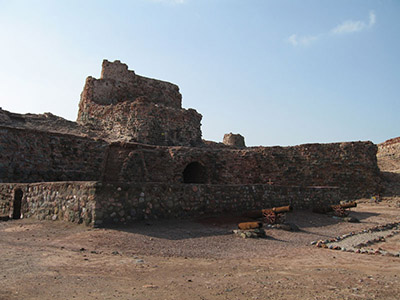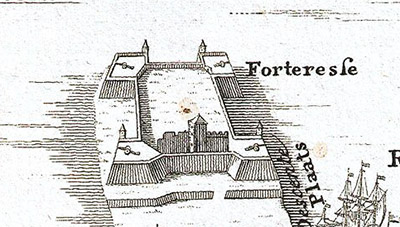 |
Fort of Our Lady
of the Conception
Hormuz, Iran
|
|
 |
Constructed: 1507-1515
Used by: Portugal
Conflicts in which it participated:
Eighty Years' War (sort of)
Also known as:
Portuguese Castle,
Castle of Ormuz
|
The Strait of Hormuz, which connects the Persian Gulf with the Arabian Sea, is only 29 miles wide at its choke point. Today the strait is the focus of a great amount of international teeth-gnashing thanks to the combination of Iran, oil and the United States, but this waterway was of vital strategic importance long before any of these entities existed (except oil).
|
 |
|
|
The Island, and Strait, of Hormuz got its name from the city of Ormuz, some 40 miles away on the coast of what is today Oman. When the Mongols invaded around 700AD, much of the city was moved to this island for defensibility purposes. Though ill-suited for long-term settlement as no food or water occurred there naturally, the city of "New Ormuz" lasted on the island long enough for old Ormuz to wither and die, whereupon the newer city, and the island, took the name of Ormuz.
|
 Crumble crumble. Crumble crumble. |
 |
In the 1420's, Hormuz Island was visited by Chinese military explorer Zheng He (1371-1433). Leading a huge fleet of modern ships, Zheng explored much of India, Arabia and Africa over the course of seven voyages.
Had the Chinese been as interested in exporting their culture and religion as the nations of Europe a century later, this would have been the moment that Zheng planted a weird triangular flag into the sand of Hormuz Island and claimed it in the holy name of His Most Imperially Regally Royal Emperor! As things were, he just kinda said, whew it's hot here, and sailed off. This left Hormuz Island, and indeed much of the rest of the world, ripe for colonial Portuguese pickings. |
|
While by no means the only European power to take the projection of its power seriously in the 15th through 19th centuries, Portugal may have projected further than any other. This tiny nation perched on the tip of Europe led the way in the Age of Discovery, and wound up with a wider spread of colonies and starforts than any other nation: South America, Africa, the Middle East and China all have Portuguese forts sprinkled liberally therein.
At the beginning of the 16th century, Ormuz was one of Arabia's chief centers of commerce, which is what drew Portuguese explorer Afonso de Albuquerque (1453-1515) there, with 500 men, in 1507. Having freshly conquered a series of nearby cities, Albuquerque had a fearsome reputation, and the local king swore fealty to the King of Portugal, whom in this case was Manuel I (1469-1521).
|
Albuquerque's mission was to dominate trade in the Persian Gulf region by squeezing out lingering Muslim and Chinese influence. The sovereign of Ormuz tremblingly gave the Portuguese permission to build a fort on the island, using local labor.
Albuquerque started work on the Fort of Our Lady of Victory (Forte de Nossa Senhora da Vitória) on October 27, 1507. By April of 1508, however, he found that he had named his fort after the wrong lady, as victory had not yet been assured. Local resistance and the rebellious nature of many of his officers ("IT'S REALLY HOT HERE, AFONSO!!!") forced Albuquerque to abandon the unfinished fort and leave the island.
|
 |
 A mid-16th century drawing of the starfort of our current interest, which obviously wasn't a starfort yet! A mid-16th century drawing of the starfort of our current interest, which obviously wasn't a starfort yet! |
|
The Portuguese returned in 1515 with 27 ships and 1500 men, determined to retake Ormuz. By April 1st of that year, Albuquerque was getting back to work on his fort, which was now named the Fort of Our Lady of the Conception ( Forte de Nossa Senhora da Conceição), which, while kind of gross, was a better name as it did not imagine victory before there was actual victory. This original fortification was more of a medieval-style castle, which makes sense given the timeframe. The very first starforts were only beginning to sprout into existence in northern Italy at the beginning of the 16th century, and the Portuguese hadn't yet caught up. The Fort of Our Lady of the Conception got its starfort upgrade around 1591, with the ministrations of Milanese military engineer Giovanni Battista Cairati (15??-1596). Cairati did lots of starfort work for the Portuguese, including the design of Fort Jesus in Mombasa, Kenya, in 1593.
|
|
 |
Forever nipping at Portugal's heels in the colonization-and-exploitation game was England, more specifically the East India Company. This was an English business enterprise with a powerful military arm, which was ultimately interested in making money, often in the lands where the Portuguese were already endeavoring to achieve the same goal.
In 1622, Persia, led by Shah Abbas I (1571-1629), allied with the East India Company to cleanse Hormuz Island of Portuguese presence. With the Persians on land and the EIC on the sea, the island and Fort of Our Lady of the Conception were wrested from the Portuguese with few casualties on the Anglo-Persian side.
|
|
This event took place during the Eighty Years' War (1568-1648), which had absolutely nothing to do with Persia, but did involve England and Spain, on opposing sides, the latter of whom had nominally swallowed Portugal from 1580 to 1640.
It was pointed out in England's Parliament that England was not at the time in a state of war with Portugal, which made this Hormuzzian feat of arms suspect. Both the Duke of Buckingham (1592-1628) and England's King James I (1566-1625) were given bribes of £10,000 courtesy of the East India Company, however, which apparently made everyone happy, except, one supposes, the Portuguese.
|
Portugal made several unsuccessful attempts to regain control of the Fort of Our Lady of the Conception over the next decade, to no avail. They had several other forts and strongholds in the region, most notably at Muscat in the current nation of Oman, but by 1650 Muscat was finally retaken by the Omani, and Portugal's reign in Arabia was at an end.
After its conquest, the Persians razed the infrastructure on Hormuz Island, and it has reportedly remained nearly desolate to this day...although there's plainly some kind of life going on there, based on satellite imagery.
|
 |
 A 1750 drawing of Hormuz Island by some dude named Schley. Click on it to see the whole island! A 1750 drawing of Hormuz Island by some dude named Schley. Click on it to see the whole island! |
|
Lastly, my first thought upon seeing the Fort of Our Lady of the Conception was that it looks just like Fort Adams!!! These two forts, separated by over two centuries and a continent, actually have virtually nothing in common, but there is a slight resemblance, n'est-ce pas?
|
|
 |
When seen side by side there might be something, but one imagines it has more to do with the limitations placed on engineers when building on a pointly little spit of land.
Many thanks to fellow starfort enthusiast Ben, who alerted me to this stellar fort. Ben suggests that the Fort of Our Lady of the Conception "must have been teleported here from Mars by the starfort loving Martians," due to its red color. Unfortunately there is no Martian-language Wikipedia page for this fort, so this is impossible to confirm.
|
|
|
|
|
|
|
 |




